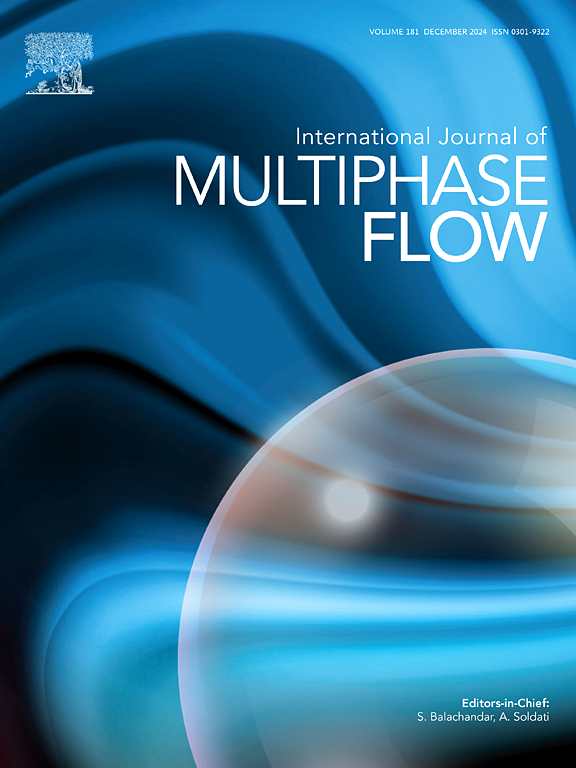气液密度比增大时多射流撞击环形液膜雾化的数值研究
IF 3.8
2区 工程技术
Q1 MECHANICS
International Journal of Multiphase Flow
Pub Date : 2025-09-20
DOI:10.1016/j.ijmultiphaseflow.2025.105450
引用次数: 0
摘要
将针状喷射器双推进剂雾化建模为多个喷嘴(氧化剂)撞击环形液片(燃料)。采用欧拉-拉格朗日耦合方法对提高气燃密度比时的雾化行为进行了数值模拟。提出了一种无需额外网格细化的双环标记算法来识别液滴。结果表明,在密度比情况下,雾化场可以用质量分数量化的三个区域(混合区、过渡区和落区)来表征。这些区域的液滴大小和混合比分布明显不同。混合区SMD减小,过渡区和下降区SMD先增大后减小。在低密度比下,混合比呈现单峰型变化趋势,而在高密度比下,混合比呈现双峰型变化趋势。为了解释密度比对上述观测结果的影响,分析了连续混合片和下落片破碎以及离散液滴聚结机理,发现密度比越高,混合区和下落区液片破裂越早,从而在过渡区产生更多的离散韧带或液滴。然而,另一方面,在足够高的密度比下,离散的韧带和液滴密集,推测它们的聚结机制是有效的,导致更大尺寸的离散液体结构和混合比的双峰变化。本文章由计算机程序翻译,如有差异,请以英文原文为准。

Numerical investigation on atomization of multiple jets impinging at an annular liquid film with elevated gas-to-liquid density ratio
Bi-propellant atomization of pintle injector is modeled as multiple jets (oxidizer) impinging an annular liquid sheet (fuel). Numerical simulation of the atomization behaviors is conducted at elevated gas to fuel density ratios with coupling Eulerian–Lagrangian approach. A dual-loop tagging algorithm is proposed to identify the droplets without additional mesh refinement. Our results show that for all density ratio cases investigated here, the atomization field can be characterized by three regions quantified by mass fraction (mixing, transition and falling region). These regions have significantly different droplet size and mixing ratio distributions. SMD decreases in the mixing region, but in the transition and falling region, SMD firstly increases and then decreases. Furthermore, at low density ratio, the mixing ratio presents the unimodal variation trend, while at high density ratio, the mixing ratio presents the bimodal mode. To interpret the effect of the density ratio on the above observations, the continuous mixing sheet and the falling sheet breakup, as well as the discrete droplet coalescence mechanism is analyzed and it is found that higher density ratio leads to advanced breakup of liquid sheets in both mixing and falling regions, which generates more discrete ligaments or droplets in the transition region. However, on the other hand, at sufficiently high density ratio, the discrete ligaments and droplets are so populated that their coalescence mechanism is speculated to be effective, leading to larger sized discrete liquid structures and bimodal variation of mixing ratio.
求助全文
通过发布文献求助,成功后即可免费获取论文全文。
去求助
来源期刊
CiteScore
7.30
自引率
10.50%
发文量
244
审稿时长
4 months
期刊介绍:
The International Journal of Multiphase Flow publishes analytical, numerical and experimental articles of lasting interest. The scope of the journal includes all aspects of mass, momentum and energy exchange phenomena among different phases such as occur in disperse flows, gas–liquid and liquid–liquid flows, flows in porous media, boiling, granular flows and others.
The journal publishes full papers, brief communications and conference announcements.

 求助内容:
求助内容: 应助结果提醒方式:
应助结果提醒方式:


